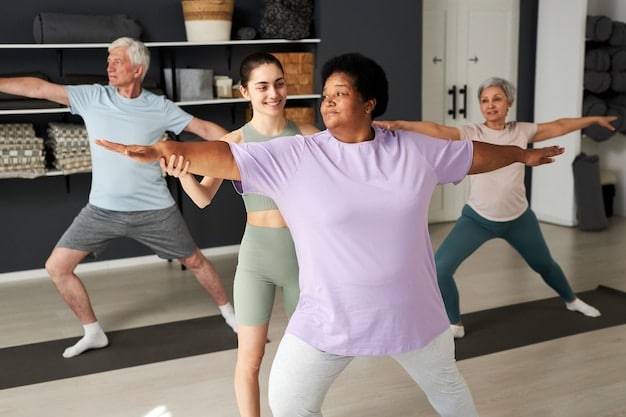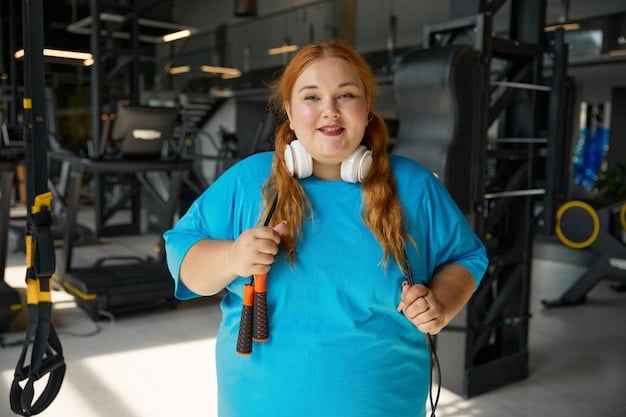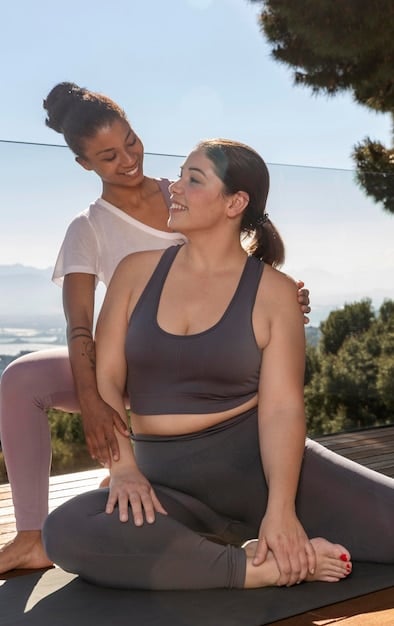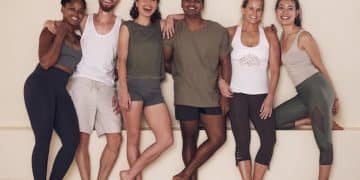Plus-Size Fitness: Find Joy in Movement at Any Size

Advertisements
Plus-size fitness emphasizes joyful movement and inclusivity, promoting well-being for individuals of all sizes by focusing on ability and enjoyment rather than traditional weight-loss goals.
Advertisements
Finding joy in movement is possible at every size. This guide explores **plus-size fitness**, focusing on how to create a positive and sustainable approach to physical activity.
Embracing Body Positivity in Fitness
Advertisements
Body positivity is a movement that encourages individuals to accept and appreciate their bodies as they are, regardless of size, shape, or perceived imperfections. In the context of fitness, it means shifting the focus from weight loss to overall well-being and celebrating what your body can do.
Embracing body positivity can transform your approach to fitness. It means finding activities that you genuinely enjoy, setting realistic goals, and focusing on the positive impact of movement on your physical and mental health.
Redefining Fitness Goals
Traditional fitness goals often revolve around weight loss, which can be discouraging and unsustainable for many. Instead, focus on goals that celebrate your body’s abilities and promote overall well-being.
Shifting the Focus
Shift your focus from losing weight to gaining strength, improving your cardiovascular health, or increasing your flexibility. These goals are more achievable and provide a more positive and empowering experience.
- Focus on Abilities: Celebrate what your body can do, rather than focusing on perceived limitations.
- Set Achievable Goals: Start with small, realistic goals and gradually increase the intensity and duration of your workouts.
- Listen to Your Body: Pay attention to your body’s signals and rest when you need to. Avoid pushing yourself too hard, especially when starting a new fitness routine.
- Celebrate Non-Scale Victories: Acknowledge and celebrate your progress, even if it’s not reflected on the scale.

Embracing body positivity in fitness is about creating a sustainable and enjoyable approach to movement that celebrates your body and promotes overall well-being. Redefining your fitness goals to focus on abilities, setting achievable targets, and listening to your body can empower you to find joy in movement at any size.
Finding Activities You Enjoy
The key to sticking with a fitness routine is to find activities that you genuinely enjoy. When exercise feels like a chore, it’s much harder to stay motivated. Experiment with different types of activities until you discover something that you look forward to doing.
There are countless ways to be active, and not all of them involve going to the gym. Explore a variety of options to find what resonates with you, whether it’s dancing, swimming, hiking, or simply taking a walk in nature.
Exploring Different Options
Don’t be afraid to try new things. You might be surprised at what you discover. Look for activities that align with your interests and personality.
Making it Social
Working out with friends or joining a fitness class can make exercise more enjoyable and provide you with a sense of community and support. Having someone to hold you accountable can also help you stay motivated.
- Dance Classes: Dance classes like Zumba or hip-hop can be a fun and energetic way to get your heart pumping.
- Swimming: Swimming is a low-impact activity that’s gentle on your joints and can be a great option for those with mobility issues.
- Yoga: Yoga can improve your flexibility, strength, and balance, while also promoting relaxation and mindfulness.
- Hiking: Hiking is a great way to enjoy the outdoors while getting a good workout.
Finding activities that you enjoy is a key component of creating a sustainable fitness routine. By exploring different options and making it social, you can discover the joy in movement and develop a positive relationship with exercise.
Addressing Common Concerns and Barriers
Many plus-size individuals face unique challenges when it comes to fitness. Addressing these concerns and barriers is crucial for creating a more inclusive and supportive fitness environment.
Common concerns include body image issues, fear of judgment, lack of appropriate clothing or equipment, and limited access to inclusive fitness spaces. Understanding these challenges is the first step towards overcoming them.
Body Image Issues
Body image issues can be a significant barrier to exercise. Many plus-size individuals feel self-conscious about their bodies and worry about being judged by others. It’s important to remember that everyone starts somewhere, and that your body is strong and capable, regardless of its size.
Finding Inclusive Spaces
Look for fitness spaces that promote body positivity and inclusivity. These spaces often have trainers who are experienced in working with plus-size individuals and offer a supportive and non-judgmental environment.
- Judgment: The fear of judgment is a common concern for plus-size individuals. Remember, you are worthy of respect and support, regardless of your size.
- Clothing and Equipment: Finding appropriate clothing and equipment can be a challenge. Many brands offer plus-size activewear, and some gyms are starting to invest in equipment that is designed for larger bodies.
- Access: Limited access to inclusive fitness spaces can be a barrier. Consider seeking out online fitness programs or creating your own workout routine at home or in a supportive outdoor environment.
Addressing common concerns and barriers is essential for promoting plus-size fitness. By confronting body image issues, finding inclusive spaces, and advocating for better resources, you can create a more supportive and empowering fitness experience for yourself and others.
Modifying Exercises for Different Body Types and Abilities
Not all exercises are created equal, and some may need to be modified to accommodate different body types and abilities. It’s important to listen to your body and adjust exercises as needed to avoid injury and ensure that you’re getting the most out of your workouts.
Modifying exercises can involve changing the range of motion, using different equipment, or substituting an exercise with a similar but less challenging variation.
Listening to Your Body
Pay attention to your body’s signals and adjust exercises as needed. If you experience pain or discomfort, stop the exercise and consult with a qualified fitness professional.
Working with a Trainer
Consider working with a personal trainer who is experienced in working with plus-size individuals. They can help you modify exercises to fit your specific needs and abilities and create a personalized workout plan that is both safe and effective.
- Range of Motion: Reduce the range of motion in exercises to avoid straining your joints.
- Equipment: Use different equipment, such as resistance bands or dumbbells, to modify the intensity of your workouts.
- Variations: Substitute exercises with similar but less challenging variations, such as wall push-ups instead of traditional push-ups.

Modifying exercises for different body types and abilities is a crucial aspect of plus-size fitness. By listening to your body, working with a qualified professional, and being willing to adjust exercises as needed, you can create a safe and effective workout routine that meets your individual needs.
Building a Supportive Community
Having a supportive community can make a big difference in your fitness journey. Surrounding yourself with people who understand your challenges and celebrate your successes can help you stay motivated and committed to your goals.
A supportive community can provide encouragement, accountability, and valuable resources. It can also help you feel less alone in your journey and connect with others who share similar experiences.
Finding Online Communities
There are many online communities dedicated to plus-size fitness. These communities can provide a safe and supportive space to share your experiences, ask questions, and connect with others who understand what you’re going through.
Joining Local Groups
Look for local fitness groups or classes that promote body positivity and inclusivity. These groups can provide you with in-person support and accountability, as well as the opportunity to build meaningful relationships.
- Social Media: Use social media to connect with others who are interested in plus-size fitness. Share your progress, ask for advice, and offer support to others.
- Fitness Challenges: Participate in online or in-person fitness challenges to stay motivated and accountable.
- Support Groups: Consider joining a support group specifically for plus-size individuals who are interested in fitness.
Building a supportive community is an invaluable asset on your fitness journey. Whether online or in-person, a strong community can provide encouragement, accountability, and a sense of belonging that can help you stay motivated and committed to your goals.
Tracking Progress and Celebrating Successes
Tracking your progress is an important part of staying motivated and seeing how far you’ve come. It’s also a great way to celebrate your successes, both big and small.
Progress can be tracked in many ways, from measuring your strength and endurance to monitoring your mood and energy levels. It’s important to find a method that works for you and that helps you stay engaged and motivated.
Setting Realistic Goals
Setting realistic goals is crucial for staying motivated and avoiding burnout. Break down your larger goals into smaller, more manageable steps and celebrate each milestone along the way.
Rewarding Yourself
Rewarding yourself for your accomplishments can help you stay motivated and reinforce positive habits. Choose rewards that are healthy and aligned with your overall goals.
- Journaling: Keep a fitness journal to track your workouts, progress, and feelings.
- Photos: Take progress photos to visually document your transformation.
- Measurements: Track your measurements to see how your body is changing over time.
Tracking progress and celebrating successes is a key component of a sustainable fitness routine. By setting realistic goals, rewarding yourself for your accomplishments, and focusing on the positive aspects of your journey, you can stay motivated and committed to your fitness goals.
| Key Point | Brief Description |
|---|---|
| 😊 Body Positivity | Embrace your body as it is and focus what it can do. |
| 🏋️♀️ Enjoyable Activities | Find exercises you love to stay motivated. |
| 🤝 Supportive Community | Connect with others for motivation and encouragement. |
| 📈 Track Progress | Monitor your progress and celebrate successes. |
Frequently Asked Questions (FAQ)
▼
Start by finding an activity you enjoy. Consult a doctor if you have health concerns. Begin slowly, setting realistic goals, and focus on how you feel, not just the numbers.
▼
Low-impact exercises such as swimming, walking, and cycling are great starting points. Modify exercises as needed to accommodate your body and ability. Listen to your body and avoid pain.
▼
Focus on what your body can do, not how it looks. Wear comfortable clothing that makes you feel good. Practice positive self-talk and remember that everyone starts somewhere.
▼
Look for online groups on social media or local fitness classes tailored to plus-size individuals. Connecting with others who understand your experience can provide motivation and encouragement.
▼
Set realistic goals and celebrate your successes, no matter how small. Find an exercise buddy, reward yourself for your accomplishments, and focus on the positive changes in your mood and energy.
Conclusion
Finding joy in movement at any size is a journey that requires patience, self-compassion, and a willingness to challenge societal norms. By embracing body positivity, finding activities you love, and building a supportive community, you can create a sustainable fitness routine that celebrates your body and promotes overall well-being.





